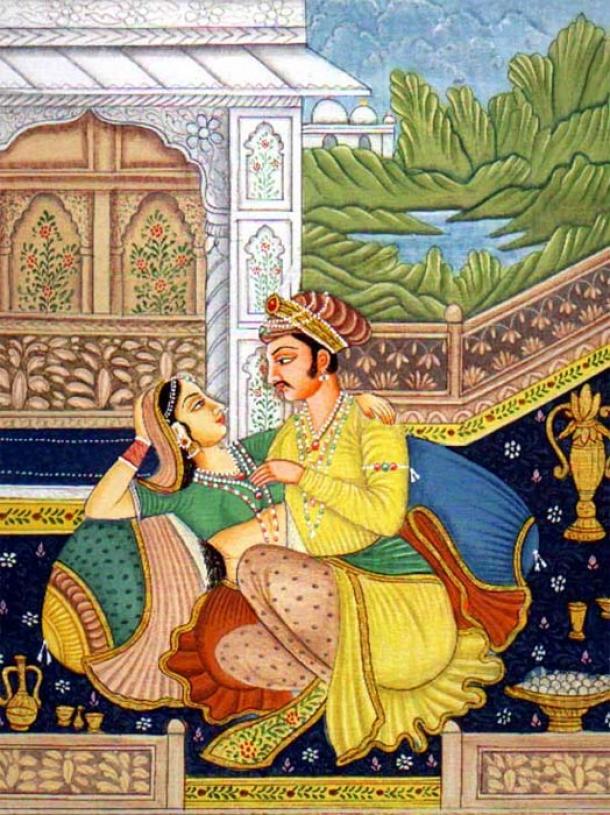Out of all the necessities in the world, three come to the forefront: food, water, and reproduction. While the first two are necessary for the survival of the individual among the many, the latter is necessary for the survival of the many. Thankfully, most people tend to enjoy the process, but in some cultures, it goes far beyond enjoyment. It is valued as an art and sometimes even worshipped as a religious ideal. Most simply call it sex; others call it a way of life. This is where the Kama Sutra comes into the story.
What is the Kama Sutra Really About?
Known in the vernacular as a book of sexual positions, the Kama Sutra is much more than a checklist of intriguing, enjoyable, and somewhat complex challenges for the bedroom . In fact, the title Kama Sutra loosely translates as a concept in which desires tie (or suture) the world together.

Govardhan. Dalliance on a Terrace 1615-20 LACMA. ( Public Domain )
The sexual aspect of the text is in actuality only a portion of kama (the Hindu term equating to ‘desires’ or ‘pleasure of the senses’), while the other aspects of the text discuss how to attract partners , how to obtain a wife, how to keep a wife, how a wife should behave, and where concubines fit into the scheme of marriage.
Kama in the most general sense of the word can refer to affection, love, aesthetic stimulation, or wishes, none of which have to incorporate sexuality. The text ends with a discussion of the inner power of those partaking in sexual acts . That is, engaging in sexual activity can be seen as a spiritual act in which one’s sexual power can be enhanced.
The Purpose of the Kama Sutra
Written (likely) by the philosopher Vatsyayana possibly around the 2nd century AD, scholars believe his intention was to highlight one of the four virtues of life. Kama, as previously mentioned, indicates enjoying the senses; the other three goals are dharma (virtuous living), artha (material wealth), and moksha (liberation—usually indicating freedom from the cycle of reincarnation). Before moving to the pleasures of life, Vatsyayana first discusses the higher goals.
But that’s not to say that following the sacred path is necessarily the aim of the text either, since pleasure is at the forefront of the work. Some scholars also question the author’s morality due to his writings on seducing the wives of other men, for example. For researchers, the text also provides unique insight on what sexuality and relationships could look like during the Gupta empire, when the text is believed to have been written.
The Kama Sutra is made up of seven books, each discussing and describing a different form of pleasure through which one can achieve kama. A common misconception is that the length of the Kama Sutra ‘s seven books dictates sexual intercourse; in truth, only one chapter in one of these seven books talks about sexual positions. In simple terms, the focus of the text is not the physical act of lovemaking, but more on achieving love and pleasure in relationships and life.

Lovers Embracing, Folio from India, Madhya Pradesh, Malwa, circa 1660. ( Public Domain )
Common Misconceptions About the Text
A common misconception regarding the Kama Sutra is the assumption by non-eastern cultures that the text is itself a guidebook to rituals relating to tantric sex. Tantra, in the simplest terms, is a state referring to mastery of the self – which in western cultures has become associated with highly ritualized sexual prowess. In truth, while sexual positions are dictated pragmatically in the text, and the text exemplifies how desire can aid in unleashing the full extent of an individual’s personal power, these dictations are intended more as guidelines for virtuous living.
The Kama Sutra does not relate to tantric rites or practices, nor is it a sacred doctrine of sexual rituals . In the grand scheme of things, the description of sexual desires and positions is very small, and is intended primarily to help individuals reach the full potential of one of the four virtuous goals of existence.
If one picks a copy of the Kama Sutra in a bookstore or searches for the text online, it is paramount to Hindu culture to ensure the text is complete and not merely an abridgement of the single chapter on sexual positions. To read this portion outside the context of the entire book is to misrepresent, and therefore misunderstand, a text which has had great significance in Indian society .

The Kama Sutra contains more than just sexual positions. ( Art of Legend India )
It is due to instances such as these that modern knowledge of the Kama Sutra is so misguided. With time, perhaps the Kama Sutra can once again be enjoyed as it was meant to be by Vatsyayana. As awareness of the genuine nature of the text is spread, so too will the true meaning behind this work be better understood.
Top Image: The Kama Sutra discusses love, pleasure, and human sexuality. Source: Public Domain
References
Doniger, Wendy. 2003. Kamasutra. Oxford University Press.
“Kama Sutra.” 2014. Indra Sinha. Accessed October 19, 2017. http://www.indrasinha.com/books-2/kama-sutra/
“The Kama Sutra of Vatsyayana.” 2008. Indohistory. Accessed October 20, 2017. http://indohistory.com/kamasutra.html
“The Kama Sutra of Vatsyayana.” 2003. (trans. Sir Richard Burton, 1883.) Accessed October 19, 2017. http://www.sacred-texts.com/sex/kama/
Keay, John. 2010. India: A History: from the Earliest Civilizations to the Boom of the Twenty-first Century. Grove Press.
Hopkins, Thomas J. 1971. The Hindu Religious Tradition . Cambridge: Dickenson Publishing Company, Inc.
Related posts:
Views: 0
 RSS Feed
RSS Feed
















 July 29th, 2020
July 29th, 2020  Awake Goy
Awake Goy  Posted in
Posted in  Tags:
Tags: 
















